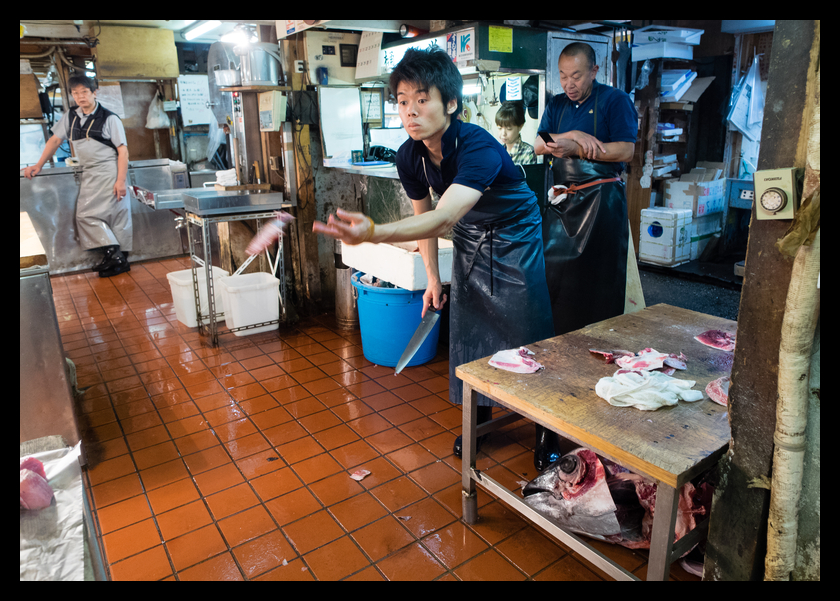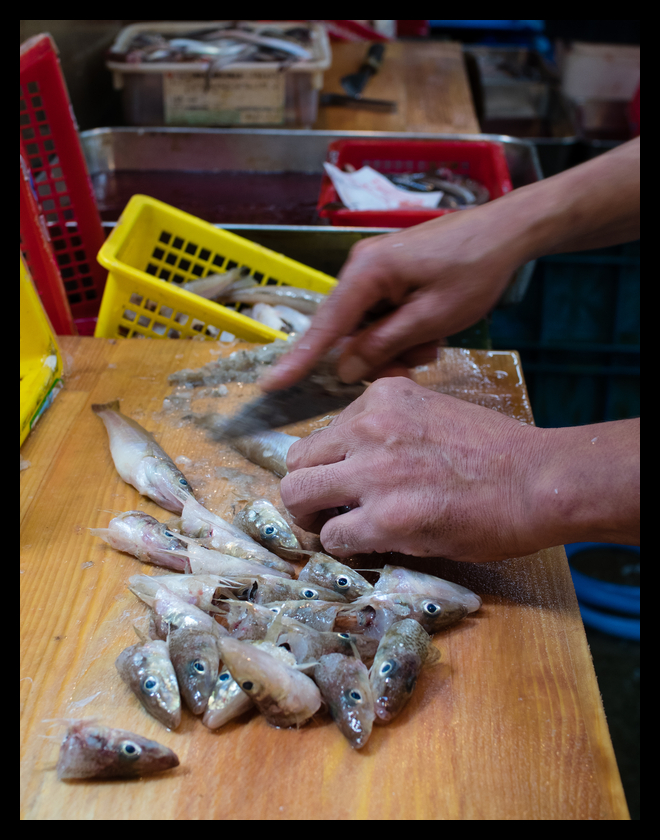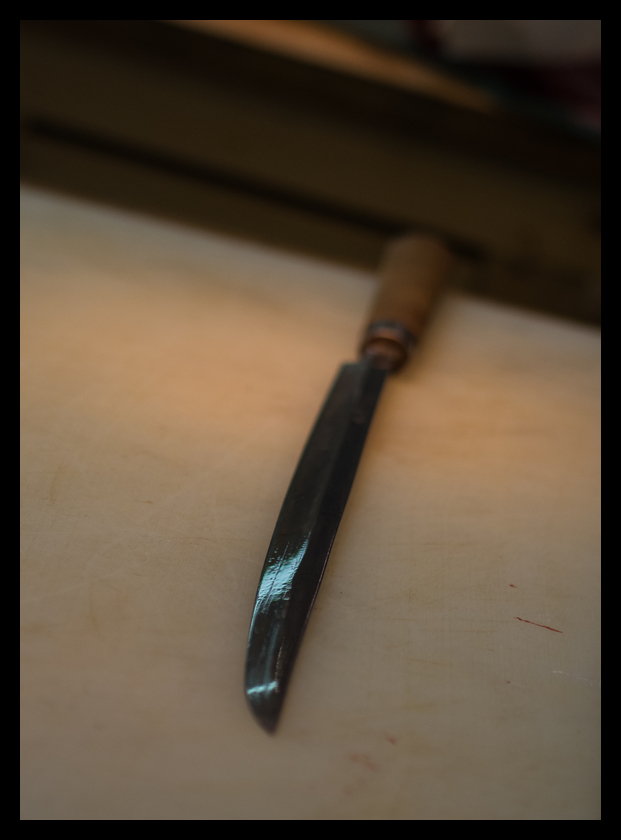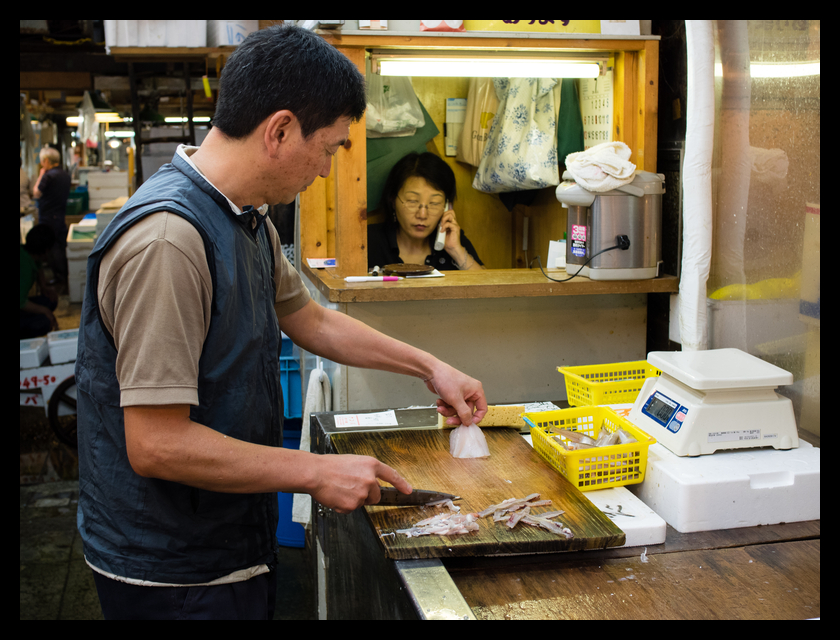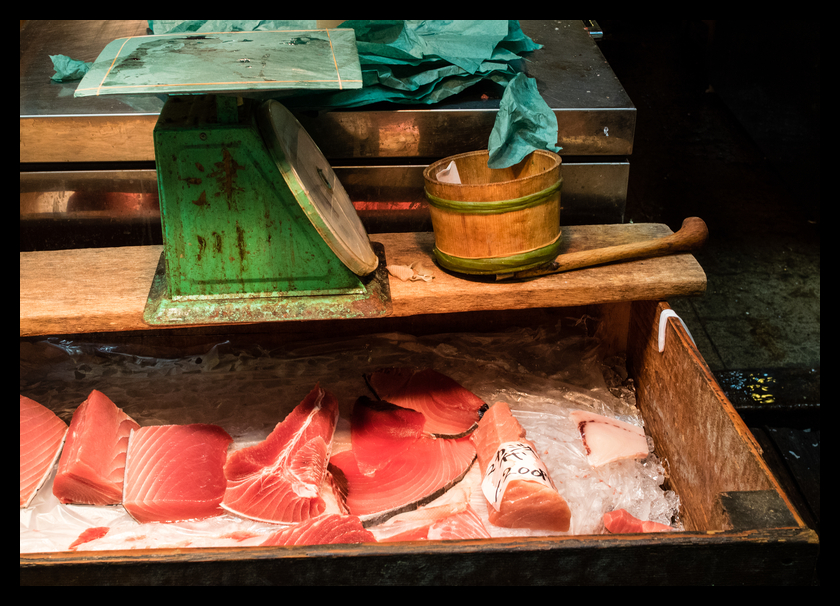A visit to the famous Tsukiji fish market in Tokyo is a must for every tourist. Said to be the world's largest fish market, its constant motion, colors and culture are a delight to be taken in. That also makes it a prime attraction for some serious photography.
The Place
The Tsukiji market has a long history. It's located at the waterfront, since in the early years fish were brought in by trawlers. That vanished and railroad tracks were installed and the fish arrived by wagon loads. Nowadays the tracks are paved over and trucks bring in fish that's sometimes flown in from faraway places to sate Tokyo's appetite for fresh sushi. Word is that the current market will disappear in the coming years and be replaced by a new one a few miles from the present location.
That's bad news for photographers. Over the years, tourists have become less welcome at Tsukiji. Until a few years ago, visitors could enter the market at any time and wander the many stalls while the main business took place. Then rude behavior by some tourists led to a complete ban on visitors. This ban is now partially lifted, but we can assume that a new facility will be designed to separate visitors from the vendors, which means photographers would not be able to see the action up close.
The guide books will tell you about the various areas of the market, but the one that you really want to capture is the so-called 'inner market.' That's where the auctions take place and where the fish is prepped for shipment throughout Tokyo. It's a maze of stalls and narrow passageways.
If possible you could spend hours walking the narrow corridors, seeking the best photo opportunities. The halls are vast, the stalls many and the concentrated activity captivating. The 'if possible' at the beginning of this paragraph is key, though, as time is your enemy.
When to Go
The market operates every day except on Sundays, Japanese holidays and some Wednesdays, but since the lifting of the total tourist ban, visitors are only allowed within certain time periods.
The highlight, the famous tuna auction, can only be attended by a limited number of outsiders, on a first-come first-serve basis. I've never been, but apparently you need to line up for tickets at 4 a.m. if you want a chance to see the auction starting at 5 a.m. Even then, you're only allowed in a special section for observers and you're only allowed to stay for part of the auction.
The general market floor nowadays remains closed to outsiders until 9 am. By that time, most of the hectic business is done and the chance that tourists mess up the market operations have lessened.
You will still find plenty to photograph, but as you wander around, the activity will start to die down and instead of people prepping fish, you will see them doing their accounts.
So, in short, if you want to witness the tuna auction, be there at 4 a.m., wait until at least 5 a.m., shoot, have breakfast and return at 9 a.m. Otherwise, be there at 9 a.m. and wander.
Note that these rules might change, so check the official market site before you go.
Shooting There
You're a visitor. Unless you're a pro, you're there for your entertainment. Keep in mind that Tsukiji was never meant to be a tourist attraction and that it's a hyperactive market where millions of dollars in fish change hands every day in a matter of hours. From the perspective of the workers, you're just in the way.
First there are many restrictions (link to PDF), to be found on the official market site in multiple languages. One of the restrictions is that large bags are forbidden. More about that later. Another one is that flash photography is not allowed.
Beyond the restrictions, you need to be cautious. The biggest danger are the specially designed lorries that zip through the market at high speeds with little regard for meandering foreigners. Stay on the side, look both ways and be prepared to move out of the way quickly.
The second biggest danger is the fact that it's crowded, wet and potentially slippery. Watch where you step. Before you take up that position to shoot, make sure you're safe there.
Finally, keep in mind that you're in other people's work space. Your leaning in for a close up, might interfere with their efficiency. Be courteous. And don't touch anything.
You'll find many other tourists with a camera there and surely every one of them has his or her own approach to photography. You can take the overview pictures of the stalls, pictures of the large variety of fish and other sea creatures and snapshots of your family and friends. We all want pictures of the large tuna, especially when they're cut up. Unfortunately, by 9 a.m., the chances of that still going on are relatively slim.
I did go at 9 a.m. and decided to focus on the workers, in between the variety of fish and still lives of the tools and instruments. Yes, I also took some family snapshots.
The workers had a mix of reactions. Most ignored me. Some were bemused. Other were rushed and a bit hostile, especially the buggy operators. I tried my best not to be in anyone's way, but with the speed at which the market operates, I was still sometimes a bother to someone.
At some point, I took close ups of a fish monger's hands cutting up fish and lifted up my camera to take his portrait. He smiled and said: 'Give me money.' I shook my head, smiled back and said: 'No, that's your work. This is my work.' He just smiled some more. I said 'domo arigato,' having found that the words for 'thank you' and a smile are the two most important tools for street shooting in any country.
Gear
I had brought my Olympus OM-D E-M1 with three Olympus lenses, the 12mm f/2, the 25mm f/1.8 and the 45mm f/1.8. The 12mm (24mm equivalent) was good for the overview shots, but is too wide to really zero in on people doing actual work. The 45mm (90mm equivalent) is good for real close up work, but generally the corridors of the market are too narrow and too tight to work with a tele lens. I found that the 25mm (50mm equivalent) was the lens that suited the circumstances best.
You do want a camera that focuses quickly and you do want to have enough depth of field to cover the main action in the picture, but not so much that the generally busy background is also fully in focus. In my case, shooting in micro four-thirds, I shot in aperture priority and mostly used apertures between f/2.8 and f/4, which translate into a safe f/5.6 and f/8 in full frame. Whenever I wanted less depth of field, I went down to f/1.8.
Shutter speeds stayed mostly around 1/60 or 1/80, which is perfectly doable with the excellent in-body stabilization of the E-M1, but which might be too slow when using lenses of similar length without stabilization. Only when I wanted to get some movement in the image did I close down the aperture far enough to get slow shutter speeds.
ISO was set at automatic and moved between 200 and 1600. I put the camera on auto white balance and didn't bother with the various kinds of light in the market, as I always shoot RAW anyway and correct in Lightroom.
Despite the flexibility of a zoom lens, I was glad I had brought the primes and left the slower Olympus 12-40mm f/2.8 PRO zoom at home. The Olympus primes are tiny, so I had one in each pocket and could quickly change lenses. I didn't bother putting caps on the lenses, since I had made sure there was nothing on my pockets that could damage them.
I did appreciate my Olympus setup, but any kit that's speedy and delivers good quality in low light would do. Except that you're not allowed to carry a large bag. This is not a place to lug a backpack full of gear. I did carry the small Think Tank Retrospective 5 bag. I carried it over my shoulder on my back, so it wouldn't be in the way.
You do want to carry spare batteries and memory cards, especially when you're shooting in bursts. Other than that, no extra gear is needed at the market.
Guidebooks generally tell you to wear old shoes and clothes when you visit Tsukiji. I ignored that advice and actually wore brand new shoes and shorts. I found that by 9 a.m. a lot of the cleaning up has already been done and the floors aren't as slippery as they used to be when the market was open to tourists earlier. Still, the odd splash might hit you, so if you want to play it safe, old shoes and clothes aren't a bad idea.
Wrap Up
Despite some of the challenges, Tsukiji is one of my favorite places to shoot in Tokyo. This was my third time there and the first time my kids were old enough to allow me some freedom to focus on shooting more than on keeping them safe.
And after all the photography there's the next highlight of any Tokyo visit: a breakfast of the freshest sushi you've ever eaten at one of the many cozy restaurants on the perimeters of the market. With beer.
By John van Rosendaal
This is one of a series of 'Wanderings' postings about photographing in various locations. Please feel free to add your own experiences in the comments.
Some more impressions:






